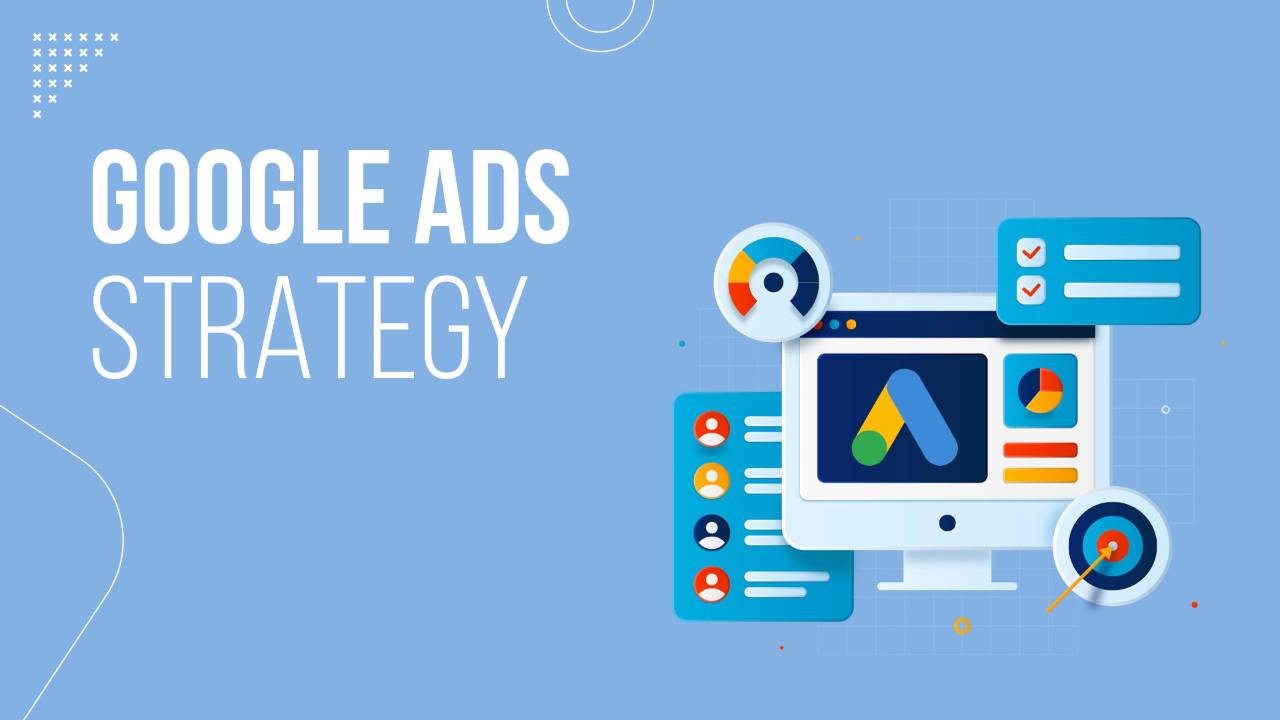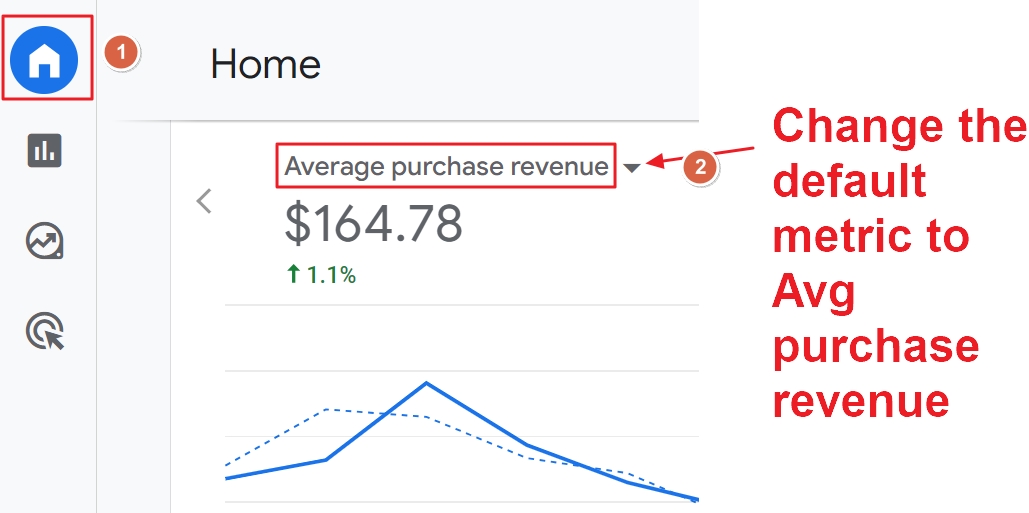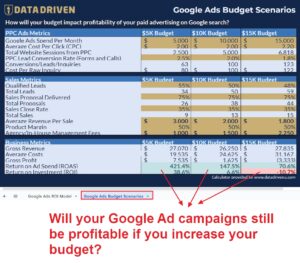Building a Google Ads budget is one of the toughest challenges faced by both new and experienced pay-per-click marketers. Budget planning can feel overwhelming, time-consuming and downright thankless. But a well-planned budget is an essential part of being successful with Google Ads.
Complicated? No, if you use my free “Million dollar Google Ads tool” just like the +10K businesses, agencies and freelancers already did …
Key takeaways
- There are many tools to calculate a Google Ads budget, but most of them only focus on paid ad metrics.
- To have a realistic view on how profitable your PPC (pay-per-click) campaigns can be, you also need to take sales and business key metrics into account.
- Even if you don’t know all the numbers, you will profit from making a financial plan for your Google Ads campaigns.
- My free downloadable Google Ads budget calculator has helped over 10,000 businesses maximize the profit from PPC advertising.
Download my free Google Ads budget calculator
During my career as a digital marketing consultant, I have been asked to plan and adjust Ads budgets on a daily basis. With that frequency, I needed an easy solution that would generate ballpark Google Ads budgets quickly and accurately.
So, I crafted a budget calculator to help clients build million-dollar Google Ads campaign strategies in just a few minutes. Now, I am sharing my Google Ads Budget Calculator with you!
You can download the Google Ads Budget Calculator for free and use it to plan your budget.

To give you a sneak preview, this is what the calculator looks like.

The rest of this post will guide you through the strategy that goes into planning a successful Google Ads budget and show you how to use the Google Ads Budget Calculator.
How to plan your Google Ads budget?
To create a profit-driven PPC strategy, we need to know some basic data about our business.
Gathering this data can be difficult, but well worth the payoff.
If you follow the four steps below, you will discover that planning your costs and potential profit from paid ads on Google is actually easier than you may have thought…
Step 1: Gather your organizational data
You only need to find out three key metrics to get started with planning Google Ads. Even if you don’t know them right now, the calculator is ideal to quickly set up paid marketing simulations and even compare different scenarios.
Estimated paid ads budget
First, you need a baseline for your paid advertising budget. Don’t overthink this, but instead follow these tips:
- Start out with an amount that you’re comfortable with spending each month.
- Make sure it's within your company’s expectations as well.
Pro tip: You can adjust your rough estimation to be more accurate as you gather data from your real-life campaigns after launch.
Average Cost-Per-Click
This is the average amount Google will charge you when one of your ads is clicked on. You can find cost-per-click estimates using the Google Keyword Planner.
Google’s Keyword planner will return a list of keyword ideas correlated with your search term. You can use the number from the suggested bids column as your cost-per-click estimate. Your actual cost-per-click will vary, so make sure to compare your initial budget to your actual results.

Be sure to take these estimates as a loose guideline and feel free to adjust based on historical advertising data you have available.
Note: When you start creating ads, you will want to go beyond Google’s Keyword Planner. In one of the courses of our Data Driven Insider program , you can learn how to do keyword research to maximize profit from campaigns in Google Search and Display.

Conversion rate
What is the rate your visitors convert into customers on your website? If you don’t know your conversion rate, use ~1-2% to start. That is the “average” for the web, although most sites convert at a much higher, or lower rate.
Pro tip: if you use Google Analytics 4 but still need to link your Google Ads account to GA4, you can use the key event rate instead of conversion rate.
Step 2: Enter your data into the Google Ads Budget Calculator
This is the fun part!! First, download our Google Ads Budget Calculator provided below. Then follow along with the rest of this guide.

The gold cells in the spreadsheet are variables you can change to see how the adjustments affect your return on investment (ROI).
Entering the data you collected in step 1 into the cells of the “PPC Ad Metrics” section will provide you with some preliminary projections, as you can see in the animation below.

Step 3: Project how online advertising affects your bottom line
To develop a budget that will accurately reflect your return on the money you spend on paid Google Ads, you need to include some of your cost and sales data in the Budget Calculator.
These values are defined below. Once again, you can use estimates if this data is not readily available to you.
Average Revenue Per Sale is the average amount of your customer’s total purchase.
Pro tip: if you have set up ecommerce tracking in Google Analytics 4, you can easily find this information on selecting Average Purchase Revenue in your home report.

Product margin is the amount of income you generate above your cost of goods sold. For example, if your cost of goods sold is $1.00 and your product price is $1.50, then your product margin is 50%.
Note: If you are primarily an online seller, then product margin and average revenue per sale are the only sales metrics you need to adjust. You can set the other sales metrics to 100%.
If you sell exclusively online and do not do any lead generation, then all the offline metrics [qualified leads, sales proposals delivered, sales close rate] should be marked 100% in the Budget Calculator. Since you're selling online, the visitors that click through on your ad will either purchase or leave your site. You could also modify this sheet to include details about any lead nurturing funnels you have in place.
Qualified Leads represent the rate at which the leads collected from your ads are connected with a sales representative.
Sales Proposals Delivered represents the rate at which your ads result in a customer receiving a price estimate.
Sales Close Rate is the percentage of leads that convert into a new customer.
Agency /In-House Management Fees is the monthly cost of managing your ad campaigns (not including your ad spend).
Step 4: Use your estimated budget to plan your Google Ads strategy
Some advertisers spend until they hit a monthly quota. Others focus entirely on revenue to guide their spending.
My strategy preference has always been to focus on maximizing profit within your desired Google Ads budget.
The key to finding the most effective Google Ads budget formula is to start out small and test your optimizations
As you make adjustments to your Google Ads marketing strategy, you can input your data back into the calculator and measure the impact on your ROI. Once your strategy starts to become effective, you can ramp up spending to increase the amount of profit your ads are generating.
You already know there are many adjustments that you can make both on and offline to increase the effectiveness of your advertising, like:
- Improving your website, landing pages, or sales funnel to increase the conversion rate is one of the most common ways to make Google Ads more profitable.
- Targeting low-cost keywords to reduce cost-per-click can also have a big impact on your ROI.
- If you’re in a low traffic market, you may need to increase the price of your product, or decrease cost, to make your ad campaigns profitable.
Now that you know how to develop a data-driven Google Ads budget, we can answer some vital questions every PPC marketer or business asks at one point.
Frequently asked questions
How much should I spend on Google Ads?
You should spend enough to test the optimizations you need to make to your advertising, sales funnel, or product offering. Then, after you’ve found the right formula, spend as much as you want, as long as it continues to be profitable!
You can use the Google Ads Budget Calculator to keep your advertising strategy on-track as changes happen over time.
How much should I spend on Google Ads per day?
To calculate a daily budget for Google Ads, you can best first determine a PPC budget for a complete month. Then you can easily calculate the average cost per day. After all, Google Ads invoices for this period and a monthly budget gives advertisers a good picture of the ad costs.
How to determine a Google Ads budget for offline sales?
If you plan on using Google Ads to traffic customers to any offline sales channels, then you want to have an idea of how successful you’ll be at converting those leads into customers.
Offline sales channels can include follow-up calls or emails made by salespeople after a customer submits information into an online form. These metrics are represented in the budget calculator by qualified leads, sales proposals delivered, and sales close rate.
How to use Google Keyword Planner to find cost-per-click estimates?

To obtain estimates in the Google Keyword Planner input any search term that you might want to advertise on into the “product or service” field. If you haven't done any keyword research yet, you can enter your website address into the “landing page” field to generate keyword ideas.
What is a realistic budget for Google Ads?
A realistic budget for Google Ads depends on many factors, like the overall marketing budget, the cost per click for your target keywords, the type of campaign you want to run, the bidding strategy, and so on.
The easiest way to figure this out is by entering your data in my free data-driven calculator that combines both your specific business data with the estimation you can easily detect in the Google Ads platform.
What is the impact of increasing your Google Ads budget on your ROI?

It’s a common mistake to think that increasing your budget for Ads will automatically result in more sales or leads. To find if that can be the case without spending a dollar on ads, you can use the Data Driven PPC budget calculator.
If you have entered all your costs, you can find a second tab in the tool that can project your expected ROI for different Ads budgets.
What to do next?
With all your data in the calculator, you get a more precise idea of how your costs affect your Google Ads budget. You can also start to see where your efforts need to be directed to create a profitable advertising strategy.
Making a data-driven PPC plan before you start advertising on Google will help you to run profitable campaigns in many ways.
- You only have to enter some key numbers and the calculator does the heavy lifting for you.
- You have clear expectations of how profitable your campaigns can be.
- You also have an outlined plan that you can use to compare your expectations with reality.
- Instead of blindly increasing your budget, you can make calculated guesses and prevent spending more than needed on paid Google ads.
- It’s never too late to correct mistakes. If you are already running ads on Google, you can still profit from the tool and adjust your budgeting strategy.
That’s it. I hope that this will help you optimize your existing or first advertising campaign on Google.

PS: if you're looking for an equally powerful calculator for Facebook Ads, be sure to check out our Meta Ad Cost Calculator.

